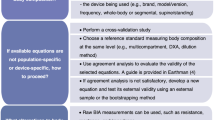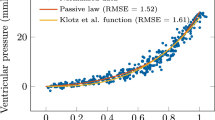Abstract
Background/Objectives:
Bioelectrical impedance vector analysis (BIVA) is increasingly used in clinical research to assess soft tissue hydration. It is known that physical characteristics of electrodes, such as low intrinsic impedance, low electrode/skin contact impedance and type of gel, affect the reliability of noninvasive bioimpedance assessments. The aim of this study was to determine the effect of intrinsic impedance of electrode on the bioimpedance vector displacement in RXc graph.
Subjects/Methods:
The intrinsic impedance is measured in nine pregelled disposable Ag/AgCl electrodes usually used for bioimpedance measures. The BIVA method is performed on 35 healthy volunteers using a 50 kHz phase-sensitive bioimpedance analyzer (BIA 101 Anniversary) with the lowest intrinsic impedance electrode and highest. The individual bioimpedance vector is plotted on the bivariate normal interval of reference population. The differences in the mean bioimpedance vectors obtained with each electrode are plotted, with their 95% confidence ellipses, on the dRXc graph. The paired one-sample Hotelling's T2-test is used to compare the differences of the mean bioimpedance vectors.
Results:
We found large variability in intrinsic resistance (11–665 Ω) and reactance (0.25–2.5 Ω) values of the electrodes analyzed and significant displacement (P<0.05) of bioimpedance vector positions in healthy adults according to the paired one-sample Hotelling's T2-test.
Conclusions:
A robust study of all physical characteristics of commercial Ag/AgCl electrodes is necessary to reach consensus on pregelled Ag/AgCl electrodes valid for bioimpedance measurement. This information will enable BIVA users to avoid systemic errors when performing BIVA assessments, specifically when these measurements are used for clinical interpretations.
This is a preview of subscription content, access via your institution
Access options
Subscribe to this journal
Receive 12 print issues and online access
$259.00 per year
only $21.58 per issue
Buy this article
- Purchase on Springer Link
- Instant access to full article PDF
Prices may be subject to local taxes which are calculated during checkout




Similar content being viewed by others
References
Lukaski HC . Evolution of bioimpedance: journey from assessment of physiological function through body fat to clinical medicine. Eur J Clin Nutr 2013; 67: S2–S9.
National Institutes of Health.. Bioelectrical impedance analysis in body composition measurement. NIH Technical Assessment Statement 1994. Am J Clin Nutr 1996; 64 (Suppl), 524S–532S.
Ellis KJ, Bell SJ, Chertow GM, Chumlea WC, Know TA, Kotler DP et al. Bioelectrical impedance methods in clinical research: a follow up to the NIH technology assessment conference. Nutrition 1999; 15: 874–880.
Kyle UG, Bosaeus I, De Lorenzo AD, Deurenberg P, Elia M, Gomez JM et al. Bioelectrical impedance analysis—part II: utilization in clinical practice. Clin Nutr 2004; 23: 1430–1453.
Schwan HP . Alternating current electrode polarisation. Biophysik 1966; 3: 181–201.
Janz GJ, Ives DJG . Silver-silver chloride electrodes. Ann NY Acad Sci 1968; 148: 210–221.
Crenner F, Angel F, Ringwald C . Ag/AgC1 electrode assembly for thin smooth muscle electromyography. Med Biol Eng Comput 1989; 27: 346–356.
McAdams ET, Henry P, Anderson JM, Jossinet J . Optimal electrolytic chloriding of silver ink electrodes for use in electrical impedance tomography. Clin Phys Physiol Mes 1992; 13 (Suppl 1), 19–23.
McAdams ET, McLaughlin J, Brown BH, McArdle F . The NIBEC E.I.T. electrode harness. In: Holder D (ed), Clinical and Physical Applications of Electrical Impedance Tomography. UCL Press: London, UK, 1993, pp 85–92.
McAdams ET, Lackermeier A, McLaughlin JA, Macken D . The linear and non-linear electrical properties of the electrode-electrolyte interface. Biosens Bioelectron 1995; 10: 67–74.
Webster JG . Medical Instrumentation, Application and Design. Willey: New York, NY, USA, 1998, pp 196–208.
Shiwei X, Dai X, Meng X, Canhua X, Chaoshuang Ch, Mengxing T et al. Performance evaluation of five types of Ag/AgCl bio-electrodes for cerebral electrical impedance tomography. Ann Biomed Eng 2011; 39: 2059–2067.
Bolton MP, Ward LC, Khan A, Campbell I, Nightingale P, Dewit O, Elia M . Sources of error in bioimpedance spectroscopy. Physiol Meas 1998; 19: 235–246.
Bogónez-Franco P, Nescolarde L, Bragós R, Rosell-Ferrer J, Yandiola I . Measurement errors in multifrequency bioelectrical impedance analyzers with and without impedance electrode mismatch. Physiol Meas 2009; 30: 573–587.
Piccoli A, Rossi B, Pillon L, Bucciante G . A new method for monitoring body fluid variation by bioimpedance analysis: The RXc graph. Kidney Int 1994; 46: 534–539.
Piccoli A, for the Italian HD-BIA Study Group. Identification of operational clues to dry weight prescription in hemodialysis using bioimpedance vector analysis. Kidney Int 1998; 53: 1036–1043.
Pillon L, Piccoli A, Lowrie EG . Vector length as a proxy for the adequacy of ultrafiltration in hemodialysis. Kidney Int 2004; 66: 1266–1271.
Nescolarde L, Piccoli A, Román A, Núñez A, Morales R, Tamayo J et al. Bioelectrical impedance vector analysis in haemodialysis patients. Relation between oedema and mortality. Physiol Meas 2004; 25: 1271–1280.
Piccoli A,, for the Italian CAPD-BIA study group. Bioelectrical impadance vector distribution in pritoneal dialysis patients with different hydration state. Kidney Int 2004; 65: 1050–1063.
Nescolarde L, Doñate T, Piccoli A, Rosell-Ferrer J . Comparison of segmental with whole-body impedance measurements in peritoneal dialysis patients. Med Eng Phys 2008; 30: 817–824.
Piccoli A, Brunani A, Savia G . Discriminating between body fat and fluid changes in the obese adult using bioimpedance vector analysis. Int J Obesity 1998; 22: 97–104.
Gastelurrutia P, Nescolarde L, Rosell-Ferrer J, Domingo M, Ribas N, Bayes-Genis A . Bioelectrical impedance vector analysis (BIVA) in stable and non stable heart failure patients: a pilot study. Int J Cardiol 2010; 146: 262–264.
Piccoli A, Codognotto M, Di Pascoli L, Boffo G, Caregaro L . Body mass index and agreement between bioimpedance and anthropometry estimates of body compartments in anorexia nervosa. J Parenter Enteral Nutr 2005; 29: 148–156.
De Palo T, Messina G, Edefonti A, Perfumo F . Normal values of the bioelectrical impedance vector in childhood and puberty. Nutrition 2000; 16: 417–424.
Piccoli A, Fanos V, Peruzzi L, Schena S, Pizzini C, Borgione S et al. Reference values of the bioelectrical impedance vector in neonates in the first week after birth. Nutrition 2002; 18: 383–387.
Margutti AV, Monteiro JP, Camelo JS . Reference distribution of the bioelectrical impedance vector in healthy term newborns. Br J Nutr 2010; 104: 1508–1513.
L'Abée C, Poorts-Borger PH, EHGN Gorter, Piccoli A, Stolk RP, Sauer PJJ . The bioelectrical impedance vector migration in healthy infants. Clin Nutr 2010; 29: 222–226.
Nescolarde L, Núñez A, Bogónez-Franco P, Lara A, Vaillant G, Morales R et al. Reference values of the bioimpedance vector components in a Caribbean population. e-SPEN J 2013; 8: e141–e144.
Ward LD, Heitman BL, Craig P, Stroud D, Azinge EC, Jebb S . Association between ethnicity, body mass index, and bioelectrical impedance. Ann NY Acad Sci 2001; 258: 199–202.
Piccoli A, Pillon L, Dumler F . Impedance vector distribution by sex, race, body mass index, and age in the United States: standard reference intervals as bivariate Z scores. Nutrition 2002; 18: 156–170.
Bosy-Westphal A, Danielzik S, Dörhöfer RP, Piccoli A, Müller MJ . Patterns of bioelectrical impedance vector distribution by body mass index and age: implications for body-composition analysis. Am J Clin Nutr 2005; 82: 60–68.
Piccoli A, Nigrelli S, Caberlotto A, Bottazzo S, Rossi B, Pillon L, Maggiore Q . Bivariate normal values of the bioelectrical impedance vector in adult and elderly populations. Am J Clin Nutr 1995; 61: 269–270.
Norman K, Syobaus N, Pirlich M, Bosy-Westphal A . Bioelectrical phase angle and impedance vector analysis—clinical relevance and applicability of impedance parameters. Clin Nutr 2012; 31: 854–861.
Camina Martín MA, De Mateo Silleras B, Nescolarde Selva L, Barrera Ortega S, Domínguez Rodríguez L, Redondo del Río MP . Bioimpedance vector analysis and conventional bioimpedance to assess body composition in elderly adults with dementia. Nutrition 2015; 31: 155–159.
Toso S, Piccoli A, Gusella M, Menon D, Bononi A, Crepaldi G . Altered tissue electric properties in lung cancer patients as detected by bioelectric impedance vector analysis. Nutrition 2000; 16: 120–124.
Lukaski HC, Piccoli A . Bioelectrical impedance vector analysis for assessment of hydration in physiological states and clinical conditions In: Preedy V (ed), Handbook of Anthropometry. Springer: London, UK, 2012, pp 287–315.
Lukaski HC, Bolonchuk WW, Hall CB, Siders WA . Validation of tetrapolar bioelectrical impedance method to assess human body composition. J Appl Physiol 1986; 60: 1327–1332.
Piccoli A, Pastori G . BIVA Software. University of Padova: Padova, Italy, 2002.
Hotelling H . The generalization of Student's ratio. Ann Math Stat 1931; 2: 360–378.
Camina Martín MA, de Mateo Silleras B, Redondo del Río MP . Body composition analysis in older adults with dementia. Anthropometry and bioelectrical impedance analysis: a critical review. Eur J Clin Nutr 2014; 68: 1228–1233.
Ward LC, Dylke E, Czerniec S, Isenring E, Kilbreath SL . Confirmation of the reference impedance ratios used for assessment of breast cancer-related lymphedema by bioelectrical impedance spectroscopy. Lymphat Res Biol 2011; 9: 47–51.
Boone KG, Holder DS . Effect of skin impedance on image quality and variability in electrical impedance tomography: a model study. Med Biol Eng Comput 1996; 34: 351–354.
Da Silva TK, Berbigier MC, Rubin Bde A, Moraes RB, Corrêa Souza G, Schweigert Perry ID . Phase angle as a prognostic marker in patients with critical illness. Nutr Clin Pract 2015; 30: 261–265.
Beberashvili I, Azar A, Sinuani I, Shapiro G, Feldman L, Stav K et al. Bioimpedance phase angle predicts muscle function, quality of life and clinical outcome in maintenance hemodialysis patients. Eur J Clin Nutr 2014; 68: 683–689.
Chumlea WC, Guo SS, Siervogel RM . Phase angle spectrum analysis and body water. Appl Radiat Isot 1998; 49: 489–491.
Norman K, Stobäus N, Zocher D, Bosy-Westphal A, Szramek A, Scheufele R et al. Cutoff percentiles of bioelectrical phase angle predict functionality, quality of life, and mortality in patients with cancer. Am J Clin Nutr 2010; 92: 612–619.
Böhm A, Heitmann BL . The use of bioelectrical impedance analysis for body composition in epidemiological studies. Eur J Clin Nutr 2013; 67: S79–S85.
Acknowledgements
We thank all volunteers for their collaboration in this work without which it would not have been possible. We also thank Dr Eng Paco Bogónez-Franco for all recommendations and advice.
Author information
Authors and Affiliations
Corresponding author
Ethics declarations
Competing interests
The authors declare no conflict of interest.
Rights and permissions
About this article
Cite this article
Nescolarde, L., Lukaski, H., De Lorenzo, A. et al. Different displacement of bioimpedance vector due to Ag/AgCl electrode effect. Eur J Clin Nutr 70, 1401–1407 (2016). https://doi.org/10.1038/ejcn.2016.121
Received:
Revised:
Accepted:
Published:
Issue Date:
DOI: https://doi.org/10.1038/ejcn.2016.121
This article is cited by
-
Bioimpedance basics and phase angle fundamentals
Reviews in Endocrine and Metabolic Disorders (2023)
-
Phase angle, muscle tissue, and resistance training
Reviews in Endocrine and Metabolic Disorders (2023)
-
Phase angle in localized bioimpedance measurements to assess and monitor muscle injury
Reviews in Endocrine and Metabolic Disorders (2023)
-
Longitudinal agreement of four bioimpedance analyzers for detecting changes in raw bioimpedance during purposeful weight gain with resistance training
European Journal of Clinical Nutrition (2021)
-
Cross-sectional and longitudinal agreement between two multifrequency bioimpedance devices for resistance, reactance, and phase angle values
European Journal of Clinical Nutrition (2020)



